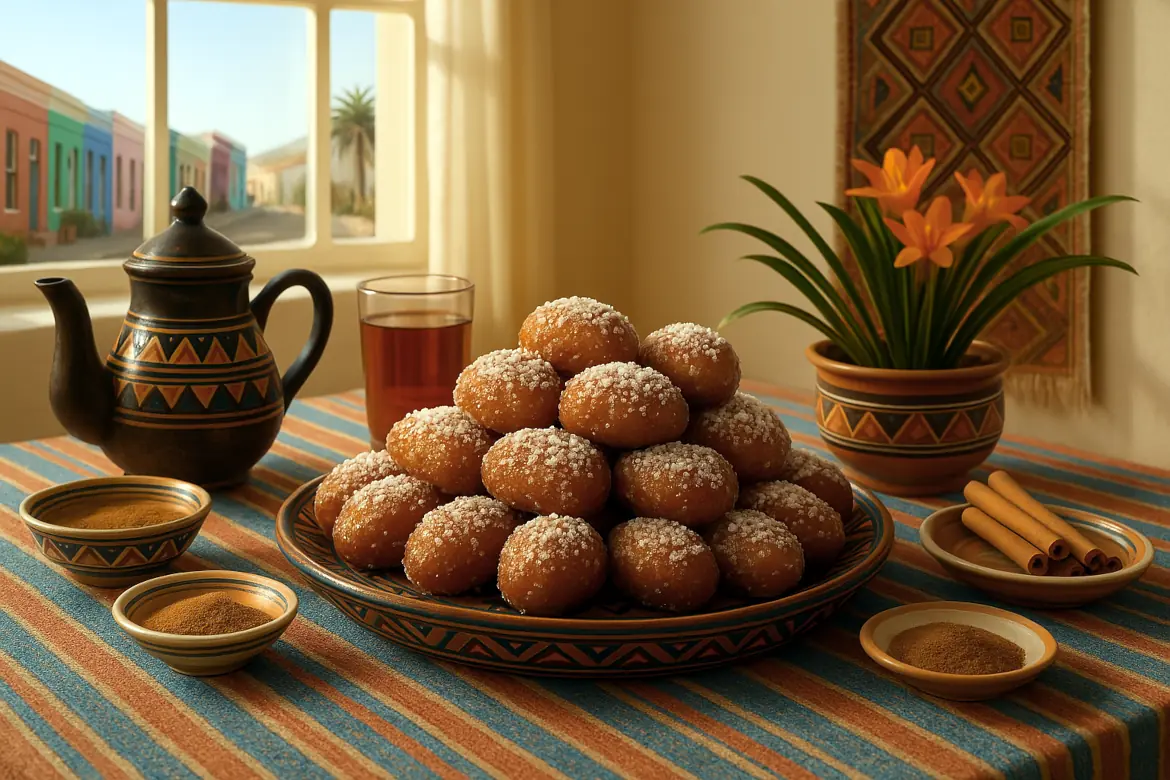The Cape Malay Koesister is more than just a sweet treat—it’s a symbol of Cape Town’s layered heritage and resilience.
This syrup-soaked, coconut-dusted pastry traces its roots to the Cape Malay community, whose ancestors—many brought to the Cape as enslaved people or political exiles—once lived and labored on Robben Island.
Writing about this delicacy is a tribute not only to its spiced, comforting flavors but also to the enduring spirit of a community that helped shape South African cuisine. The Cape Malay Koesister, with its gentle blend of cardamom, cinnamon, and ginger, offers a taste of history that continues to be passed down every Sunday morning, from family kitchens to ferry rides across Table Bay.
Table of Contents
Why the Cape Malay Koesister Is a Cape Town Icon
Cape Malay Koesisters are a delicious embodiment of Cape Town’s cultural fusion, drawing on techniques and flavors from Malaysian, Indonesian, Indian, and African food traditions. The result is a soft, pillowy doughnut infused with warming spices and soaked in syrup, then rolled in desiccated coconut for a subtle, nutty finish.
Unlike the crisp, braided Afrikaner koeksister, the Cape Malay Koesister is round, tender, and soaked in warm syrup after frying, not before. It’s typically enjoyed on Sunday mornings with rooibos tea or coffee, often shared among neighbors and family—a tradition born from generations of community, comfort, and celebration.
Cape Malay Koesister and Robben Island: A Shared Legacy
Many people visiting Robben Island know it as the prison that once held Nelson Mandela. But few realize the deep Cape Malay heritage woven into the island’s earlier history. The island was once home to political exiles and enslaved people, many of whom came from Southeast Asia, India, and East Africa—communities that laid the cultural and culinary foundations of the Cape Malay identity.
Bringing Cape Malay Koesisters on your trip to or heading out to Duiker Island, a rugged outcrop teeming with playful Cape fur seals, or Robben Island isn’t just packing a snack—it’s carrying a piece of heritage back to a place where it began. Each bite speaks to survival, cultural preservation, and the richness of Cape Town’s shared memory.
Cape Malay Koesister Recipe: Step-by-Step Guide
Ready to make your own Cape Malay Koesisters at home? This recipe brings you the traditional method passed down through generations, with soft dough, fragrant spice, sweet syrup, and coconut to finish.
- Serves: 8 (20–24 koesisters)
- Prep Time: 2 hours (includes proving)
- Cooking Time: 30 minutes
- Calories: 200 per koesister
- Recipe Cuisine: Cape Malay
- Recipe Keywords: Cape Malay Koesister, traditional South African dessert, spiced pastry, coconut-coated dessert, Cape Town snacks, island snack
Ingredients
For the dough:
- 500g cake flour
- 1 packet (10g) instant dry yeast
- 1 tsp baking powder
- ½ tsp salt
- 2 tsp ground cinnamon
- 1 tsp ground ginger
- 1 tsp ground cardamom
- ¼ cup sugar
- 2 tbsp soft butter or margarine
- 1 egg
- 1½ cups lukewarm water (adjust if needed)
For the syrup:
- 2 cups sugar
- 1 cup water
- 2-3 cardamom pods (optional)
- 1 tsp vanilla essence or a stick of cinnamon
For coating:
- 1–2 cups desiccated coconut
Method:
- Make the dough: In a large mixing bowl, combine flour, yeast, baking powder, salt, and spices. Add the sugar and mix well.
- Rub in the butter using your fingertips until the mixture resembles breadcrumbs.
- Beat the egg and add it to the dry ingredients along with lukewarm water. Mix to form a soft, slightly sticky dough. Knead for about 8–10 minutes until smooth and elastic.
- Cover the bowl with a clean kitchen towel or clingwrap. Let the dough rise in a warm spot for about 1 to 1½ hours, or until doubled in size.
- Shape the koesisters: Once risen, punch down the dough. Lightly flour your hands and roll the dough into golf ball-sized pieces (about 40–50g each). Slightly flatten or elongate each ball if you like.
- Let the shaped dough rest on a floured tray for another 15–20 minutes to puff up slightly.
- Fry them: Heat oil in a deep pan over medium heat. Fry a few at a time until golden brown on both sides, turning them gently. Drain on paper towels.
- Make the syrup: While the koesisters are cooling slightly, prepare the syrup by boiling the sugar, water, and optional spices together until slightly thickened (about 5–7 minutes). Add vanilla at the end.
- Dip each fried koesister into the warm syrup for a few seconds until well-coated, then immediately roll in desiccated coconut.
Tips for Your Island Adventure
- Storage: Koesisters can be stored in an airtight container for up to 3 days. Reheat slightly before serving.
- Packing tip: Wrap each in wax paper or layer them with parchment in a container for easy, no-mess travel.
- Drink pairing: A flask of spiced chai or sweet, milky rooibos tea pairs beautifully with the aromatic spices of the Cape Malay Koesister.
- Island tip: Whether you’re heading to Robben Island or Duiker Island to spot Cape fur seals, a few koesisters in your bag bring Cape Town’s flavor to every step of your journey.
Enjoy your meal! Geniet jou ete!
Direct Ferries
Routes, Schedules, Prices
Ferries in Africa
Next on Your Culinary Adventure:
- Sea Buckthorn Cheesecake Recipe
- Baltrum Butterkuchen Recipe
- Sicilian-Style Vegetarian Arancini Recipe
- Salmon Musubi With Spicy Avocado Crema Recipe

